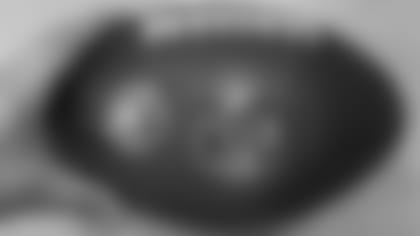Their contribution to resolving play reviews is limited. But pylon cameras - used by CBS in its coverage of AFC playoffs game last weekend - provided fans an engaging, up-close-and-personal glimpse of action around the end zone (in some cases before being run over by approaching players).

Pylon cameras don't completely satisfy those calling for fixed perimeter cams to help with officiating - especially in and near the end zones. Pylon cameras, used by broadcasters for college and pro telecasts, do however, add captivating video for the viewing audience.
Helping Officials
The views of those pylon cams used in the two CBS AFC telecasts were prominent in showing fans plays that were being reviewed. Since they are part of the broadcast, pylon camera (footage) has been added to the list of camera video that officials and those at NFL headquarters in New York can use to decide a replay.

In fact, according to a NFL source, pylon cams and any other cameras used in the broadcast of a NFL game can be used in this often make-or-break process. "Team cameras," such as those installed in scoreboards, cannot.
Pylon cameras were set up in the end zones for both of the AFC divisional matches this past weekend. The footage that the HD cams in the orange pylons contributed was magnetic and included in what CBS showed viewers at home on certain replay situations. Their shots captured approaching players and quick looks along the front of the end zone.
Pylon cams have also proven popular when used with college football contests by broadcasters. In the past, for example, ESPN has put them to use in college football playoff games to augment their field of play camera coverage. Pylon cameras have been used in the last two Super Bowls.
NBC Sports plans to use 12 pylon cameras - six in each end zone - to help cover the areas in its telecast of Super Bowl 52 next month
Shortcomings
The development and evolution of pylon cameras dates back many years as has the call from the Patriots' head coach for fixed perimeter cameras in each stadium. The plan has not materialized because of their alleged high cost.
As they are on/in the field of play, many pylon cameras are now constructed to break away when struck by players. The dislodging of these lightweight pylons and the cameras they house, typically ends the video recording, limiting their value in the bigger picture effort of officials to decide replays.
Research and Development
Early pylon approaches required a metal plate and a hard-wired connection to each unit. This approach didn't make the cut for the NFL as the resulting area didn't meet field safety requirements. Tech folks went back to the drawing board and tests that resulted in the pylons we see today.

One tech enhancement to certain pylon cameras is the addition of audio support. Units set for use in the Super Bowl next month can deliver video and audio to viewers.
Though the league has worked hard to evolve pylon cams and drive their use, it's well aware that the devices don't solve all problems.
"The new angles mostly enhance the viewer's experience, but are unlikely to be the panacea some want in the instant replay process," according to a NFL executive quoted on a league web site. "While a player's feet may be shown or if the football crossed the goal line, the pylons may not do both at the same time, which is what is required in the replay process."
The Fixed Cam Solution?
Fixed cameras installed in each NFL venue could help determine replays in and around the goal line. It's unclear, however, how they could help in cases where their view is partially or totally obscured by the type of body pileups as runners look to break the plane before there are judged down.
To be fair, pylon cams could have many of the same challenges in such situations.

But with the evolution of what constitutes a catch - combined with an increase in passing plays by teams in the red zone looking to get to the end zone - wouldn't fixed cameras help determine the final outcome of more potential scoring plays?
With pylon cams a work-in-progress and fixed cams a continued uncertainty, can non-camera technology help with determining the location of the ball?
Location, Location, Location
Before the 2017 season came word that the NFL would install RFID chips in Wilson footballs to track their flight during kicks and more. That raised questions as to whether this tried-and-true location tracking tech (already used in retail and other industries far beyond pro football) could provide an answer in situations where cameras couldn't see the action and/or the ball became obscured in player pileups.
Chipping In?
During the regular season, some thought that the NFL's equipping of footballs with RFID chips could help officials more accurately locate a ball after a play, perhaps replacing or offering an alternative to the longstanding "chain gang" approach for measuring for first downs.
While it sounds like a great application of tech that balances with the game's tradition, where is the chip located inside the ball? For making first down measurements you'd want it in the tip, but which tip?

And if the ball is obscured from cameras and under bodies is the RFID signal enough? The answer for now is no. And at what point do you mark the ball if ut moves under the player pile? That has yet to be determined.
Remember, the NFL-Zebra chip initiative begun in 2014 was designed to collect data to create Next-Gen Stats that are designed to boost the viewing experience for fans.
However, the league says its Competition Committee "will also use the insights to determine how the league and its teams can best leverage the data in the future."
The Bottom Line
Efforts to video and track the football in NFL games are varied with no silver bullet in sight. But with that said, you can be sure the league is continuing to advance and evaluate its technology options.
In fact, look for options to be in the house for the NFL's three large tech testbeds which start soon; the Pro Bowl this month, the Scouting Combine and the 2018 NFL Preseason. And expect NFL tech partners to be in lockstep with their largest client.
Stay tuned.
Bob Wallace is a technology journalist with over 30 years of experience explaining how new services, apps, consumer electronic devices and video sources are reshaping the wide world of sports. Wallace has specific expertise in explaining developments at the intersection of sports and technology. He's the Founder of Fast Forward Thinking LLC.
































